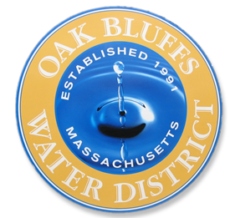Recently the Environment Protection Agency (EPA) rolled out new regulations related to the group of chemicals known as PFAS. As the public is aware, we have detected PFAS in our water system particularly at our Lagoon Pond and Farm Neck well sites while the other 3 well sites have received non-detects. Our most recent results have shown that we are below the maximum contaminant level (MCL) for PFAS, and our drinking water is safe to drink. We are dedicated to bringing safe drinking water to our customers and will continue to update the public on where our PFAS concentrations are as we continue our water sampling plan.
Since we have detected PFAS in the past, we, in conjunction with an engineering company Environmental Partners, have started a “PFAS Preparedness Study” that will detail exactly how to handle our situation moving forward. This includes the possibility, pending the results of the study, of a treatment facility in the future and any other potential options they may deem appropriate or necessary. As always, we will continue to take part in conversations with the EPA and MassDEP about where we stand and what we need to do moving forward. As it currently stands, we have not received any mandates or changes to our water system from these regulatory agencies in regard to the treatment of PFAS but that does not mean that we aren’t considering the possibility of treatment in the future. We are not taking a passive stance on PFAS and waiting for the regulatory agencies to mandate changes, we are getting ahead of potential issues that could appear later down the road, which is why we are having this study conducted.
The new PFAS rule changes the MCLs of currently regulated PFAS compounds and also splits up the PFAS6 category into individual chemicals instead of being considered altogether. Instead of having a combination of 6 different regulated PFAS compounds (PFDA, PFHPA, PFHxS, PFNA, PFOS, PFOA) compiled into PFAS6, it has been split up into individual chemicals and a hazard index that considers the health effects of mixtures of PFAS chemicals. As a result, even if you’re under the MCL for some of the PFAS chemicals, the hazard index will be a way to see if these chemicals are still a detriment to human health as a mixture despite being in an acceptable range as individual chemicals.
The following are our numbers as it currently stands at two of our five sources:
Lagoon Pond Well #1 Results:
| Chemical | October 2021 | October 2022 | January 2023 | October 2024 | MCL |
| PFOS Concentration (ppt) | 1.590 | 0.944 | 2.530 | 2.530 | 4.000 |
| PFOA Concentration (ppt) | 0.909 | 4.790 | 1.950 | 1.610 | 4.000 |
| Hazard Index | 0.072 | 0.216 | 0.083 | 0.177 | 1.000 |
Farm Neck Well #2 Results:
| Chemical | October 2021 | October 2022 | January 2023 | October 2024 | MCL |
| PFOS Concentration (ppt) | 1.570 | 0.658 | 1.810 | 1.450 | 4.000 |
| PFOA Concentration (ppt) | 3.370 | 0.805 | 3.790 | 3.890 | 4.000 |
| Hazard Index | 0.143 | 0.106 | 0.137 | 0.123 | 1.000 |
As seen above, we have remained below the newly passed MCLs except for one of the results at Lagoon Pond Well #1 in January 2022. Under MASSDEP regulations at the time, this PFOA result was combined in PFAS6 (total), we were not and have never been in violation of PFAS concentrations as these changes do not apply retroactively.
As we gather more data and continue to have important discussions with both the engineers conducting our PFAS preparedness study and the agencies that regulate drinking water, we are and always will be committed to providing the public with safe, potable, water and will inform the public if there is ever any risk to your health. Generally, there is not public notification if our levels are in an acceptable range by our regulatory agency’s standards, we do however publish this information in our Consumer Confidence Report (CCR), which is released yearly and available on our website if you want to stay up to date on any of the chemicals we tested for throughout the year.
